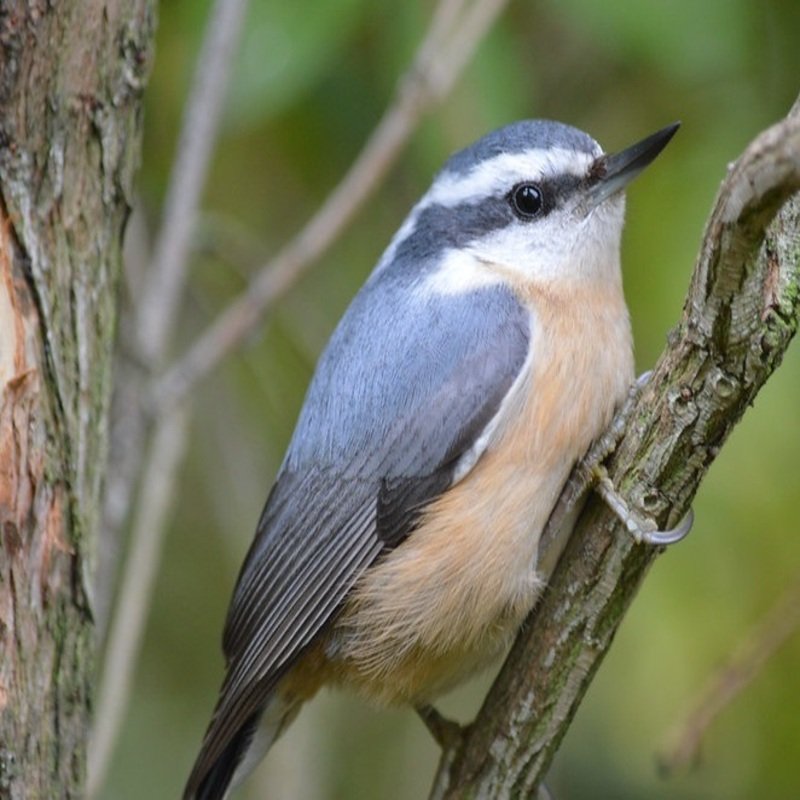Sitta canadensis, the red-breasted nuthatch, have blue-grey upperparts and cinnamon underparts, a white neck and face, a straight grey bill, and a black crown. Its cry is high-pitched and nasal, like a tin trumpet. A permanent inhabitant, it irrupts further south when its food supply runs out. Vagrants have been reported as far south as the Gulf Coast and northern Mexico. It feeds on tree trunks and big branches, sometimes catching insects in flight. Mainly insects and seeds, especially conifer seeds. The escarpment is used to seal the entrance to its nest in deadwood near the ground.
Quick Overview: Sitta Canadensis – Red-Breasted Nuthatch
Body size: Around 4.5 in (11 cm) and a weight of 11 g (0.4 oz)
Main colors: Black, White, Blue-gray, Yellow, Brown
Range: Throughout the United States
Migratory Bird: Yes
Best time of the year to see in the U.S.: All Year
Conservation Status: Least Concern
Red-breasted nuthatch Description
A long tapering beak and compact body characterize Red-breasted Nuthatches. As a result, they may descend trees headfirst or travel down the undersides of branches with their back to the ground. They average 11.5 cm in length and 10 g in weight. An eye stripe of black and white is unique to this North American nuthatch. Other distinctive features include a black crown on the head, a bluish-gray back, and a yellow or brown underbelly. The chin, cheeks, and neck are white, while the outer tail feathers have white bands and black tips. Their ten primary flying feathers are long and pointed.

Size
These birds have a length of 4.5 in (11 cm) and a weight of 11 g (0.4 oz). Their wings could range 8 in (20 cm).
Feeding
It feeds on pine, spruce, and other conifer seeds and insects such as beetles, wasps, caterpillars, crane flies, moths, and insect eggs (BirdLife). During the breeding season, the diet consists of arthropods and conifer seeds. The young are only fed insects.
Habitat
In mature coniferous or mixed conifer-deciduous forests, red-breasted nuthatches breed. They like stands with a towering canopy and a thick seedling understory. This structure protects arthropods against predators and adverse environmental circumstances.
Behavior
Unlike many other bark gleaning species, red-breasted nuthatches use one foot higher to hang from and the other lower for support. This allows them to descend trees headfirst. Climbing down trees allows them easier access to food in bark cracks that up-climbing species miss.
Red-breasted nuthatch Scientific Classification
- Kingdom: Animalia
- Phylum: Chordata
- Subphylum: Chelicerata
- Class: Aves
- Order: Passeriformes
- Family: Sittidae
- Genus: Sitta
- Species: Sitta canadensis
Best time of the year to see
In the United States, the best time of year to see these birds is all year round, regardless of the season. This refers to any month of the year between January and December.
Distribution of the Red-breasted nuthatch in the USA
Sitta canadensis is found in the Nearctic. It is the only migratory Sittidae species. Alaska, Yukon, Mackenzie Valley, central Quebec, and Newfoundland are among its northern breeding range. It breeds in the United States from central Minnesota to northern California. They breed throughout the east coast from southern New York to eastern Tennessee and western North Carolina. It sporadically migrates to southern Arizona, New Mexico, Texas, and northern Florida.
The red-breasted nuthatch can be also found in the following states in the United States – Alabama, Arizona, Arkansas, Colorado, Connecticut, Delaware, Georgia, Hawaii, Idaho, Illinois, Indiana, Iowa, Kansas, Kentucky, Louisiana, Maine, Maryland, Massachusetts, Michigan, Mississippi, Missouri, Montana, Nebraska, Nevada, New Hampshire, New Jersey, North Dakota, Ohio, Oklahoma, Oregon, Pennsylvania, Rhode Island, South Carolina, South Dakota, Utah, Vermont, Virginia, Washington, West Virginia, Wisconsin, and Wyoming.
